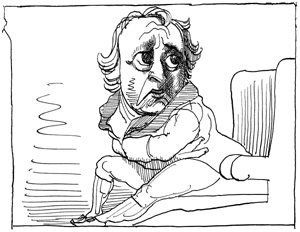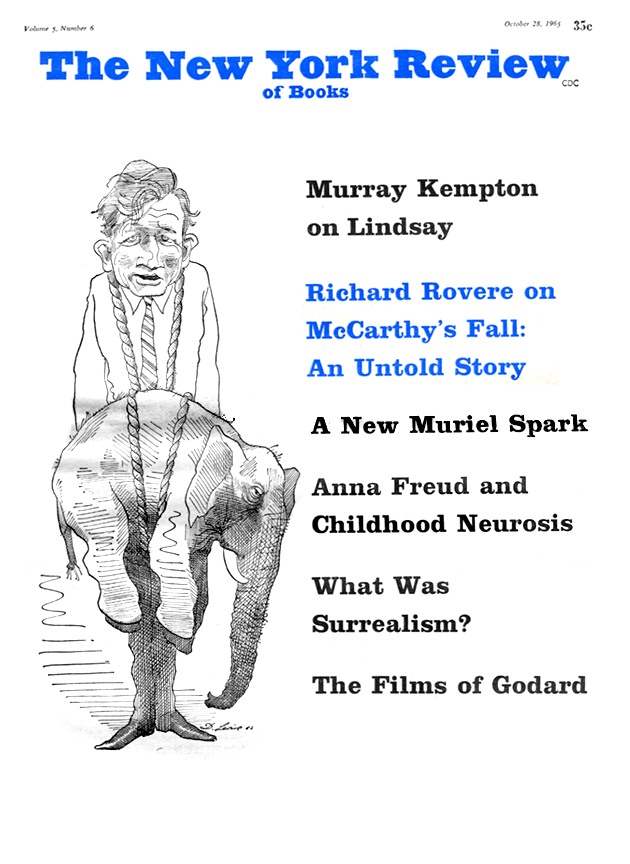In the House of Commons a hundred years ago a false quantity in a Latin quotation might ruin a promising political career. So at any rate the legend goes. Today, if an episode for which I happen to have first-hand authority is representative, a misquotation from Blake—the one English Romantic who is still universally O.K.—seems to be the comparable faux pas. The episode occurred a few years ago at a meeting, as I understand, of Harold Macmillan’s cabinet, when Iain Macleod, the Minister of Health, was using Blake to confirm the platitude that persuasion is preferable to compulsion:
He who binds to himself a joy
Doth the winged life destroy.
If Blake said it, it must be right. But at this point a colleague interrupted. “You’ve got it wrong, Iain; what Blake wrote was ‘He who bends to himself a joy’.” To which Macleod, who is not an easy man to disconcert, retorted by betting him a fiver that Blake did write “binds.” Alas, in due course the Oxford Poets edition of Blake’s poetry was produced, and there undeniably the first of “Several Questions Answered” does read “bends” with no sign of a “binds” anywhere. But a Scot, however eminent, doesn’t like to lose five pounds, and so after honorably paying up Macleod consulted a Blakeman, who was able to assure him that “binds” is at least as good a reading as “bends” and is in fact the one preferred by Geoffrey Keynes, the doyen of British Blakemen. The fiver was thereupon repaid, and Macleod and his challenger were able to shake hands in the agreeable conviction that they were both right.
But were they? The standards of Blakemanship have become increasingly rigorous over the last sixty years. In 1905 John Sampson’s Oxford edition was a remarkable textual achievement, which still has its uses, but for most purposes it was superseded in 1925 by Keynes’s edition of the complete works, poetry and prose, and the 1925 Keynes was itself superseded by Keynes’s magnificent 1957 edition. It is of the essence, however, of the sacrificial ritual of textual scholarship that he who slays the slayer shall himself be slain. David V. Erdman’s edition of Blake, which has just been brought out in a handsome volume by Doubleday, is in fact as much superior to Keynes as Keynes was to Sampson and Sampson was to his predecessors (such as the weird Ellis and Yeats edition).
The variety of media in which Blake’s writings have come down to us and the fact that almost everything he wrote was revised at least once combine to make it as difficult to establish a definitive text of Blake as of Shakespeare, though the actual editorial problems are quite different. Nevertheless what Erdman has accomplished with Blake is broadly parallel to the work of such modern Shakespearians as Charlton Hinman, whose collating machine made such startling discoveries for us about the 1623 folio, or Fredson Bowers, the prophet of compositor-analysis. All three—it is perhaps significant that they are all Americans—are primarily concerned to establish the physical facts relevant to the particular textual problem. Shakespeare’s meaning lies behind the longlost manuscripts that his earliest printers did their imperfect best to translate into the conventions of their imperfect presses. Blake’s meaning, on the other hand, apart from his few poems printed in the ordinary way, lies either behind what he himself engraved in what he called “Illuminated Printing,” or else behind the autograph manuscripts, which vary from almost unreadable pencil drafts to a beautiful copper-plate script. The crucial preliminary problem then is simply to make out what Blake wrote—including, of course, what he wrote before he deleted the manuscript or erased the engraving (or the copper-plate script). Erdman has used the modern aids such as infra-red photography, microphotography and a powerful magnifying glass to help his own sharp and experienced eyes, but his real achievement has simply been to look at the physical realities of Blake’s text more closely and intelligently than any previous editor.
A copy of Erdman’s edition will no doubt soon find its way into the library of the House of Commons. When it does I hope Iain Macleod will turn to page 770 of the Textual Notes, where he will find the following consolatory sentence:
I binds/Previous editors have wavered between “bends” and “binds”, but the dot on the i is visible in strong light (the whole poem is in pencil)
Ex pede Herculem. This one note is typical of Erdman’s thoroughness throughout, though his most spectacular discoveries of new readings are in the longer poems, especially Jerusalem. But to the literary detective much the most interesting of Erdman’s finds is the clue that Blake’s g provides to the date when a plate was engraved. Until 1791 or 1792 the g, it appears, is always topped by a rightward-pointing twiggle (“serif”), which then suddenly and with complete consistency changes round and points to the left. Finally, soon after June 1805, the serif turns and points to the right again; some plates that were retouched after this date even have the rightward serif added without the leftward one being erased.
Advertisement
The mutable serif has important critical implications. Anybody who has ever read Blake’s Thel, which is dated 1789 on the engraved frontispiece, will have been puzzled by the contradiction between the milk and honey of the first hundred lines and the smoke and fire of the last twenty. After the edifying pastoralisms of the Lily of the Valley, the Cloud and the Worm it is disconcerting to end up with the “terrific porter” of the eternal gates’ northern bar and Thel’s grave plot—and the sexual posers its “hollow pit” enunciates. But the anomaly is explained, if not justified, by the different serifs over the g in the two passages. In lines I to 103 the twiggle points to the right (which is what one would expect in 1789), whereas the last 22 lines are on a separate plate with every single g twiggling to the left. In other words, the last plate—and as it happens the one with “Thel’s Motto” on it too—must have been engraved in 1791 at the earliest. Which means that they may well have been composed two or three years after the rest of the poem. Now between 1789 and 1791 Blake had been through the Innocence of Swedenborgianism and had come out on the other side—in the Experience symbolized by Tom Paine and the French Revolution, Mary Wollstonecraft and Free Love, and Thomas Taylor’s Neo-Platonism (which contributed the eternal gates’ northern bar). No wonder the styles contradict each other.
The serifs also serve to unlock problems of interpretation in The Marriage of Heaven and Hell, thirteen of the plates having the rightward-pointing g and fourteen its leftward-pointing successor. Unfortunately Harold Bloom, who contributes some eighty pages of “Commentary,” has not fully realized the importance of dating the various strata in Blake’s writings, and his interpretations, though generally sensible and useful, are not of comparable significance to Erdman’s work on Blake’s text. Songs of Innocence and of Experience is omitted from the commentary on the ground that “a wealth of criticism is available elsewhere”—which is perhaps so but this critical wealth is widely scattered and not all of it is true coin. I suspect that the real reason for the omission is that Bloom’s Blakemanship, like that of his master Northrop Frye, is myth-minded rather than style-minded (as British criticism of Blake tends to be). More than three-quarters of the Commentary is in fact devoted to Milton, Jerusalem, and The Four Zoas, those would-be epics that the Common Reader still finds almost wholly unreadable. I did read every word of them once, some years ago, and have no intention whatever of repeating the mental strife they provoked in me. Blake was a lyrical genius, but if the lyric genius is subtracted from the later Prophetic Books what is left is to me painfully suggestive of The Book of Mormon, which as it happens was revealed to Joseph Smith of Manchester, N. Y., in the year that Blake died.
Modern editions of The Book of Mormon are equipped with an index, in which you will find such indispensable items of information as “Agosh, battle-ground of Lib and Coriamtumr” (with the reference). It would be unfair to describe S. Foster Damon’s Blake Dictionary as the Blakian equivalent of the Mormon index, but the embarrassing parallel does suggest itself in such an entry as the following:
The ARCHIEREUS is the office of high priest, one of the six in the religious hierarchy, which remains in spite of the Crucifixion. The six are “twelvefold in Allegoric pomp,” being “double, each withoutside of the other, covering eastern heaven”; they are beheld in the revelation of the Covering Cherub (Jerusalem 89: 5-9).
It’s Blake’s fault, of course, not Damon’s, whose William Blake: his Philosophy and Symbols (1924) has been the foundation stone on which all modern interpretations of Blake have built. The Dictionary is extraordinarily comprehensive, indispensable for the aspiring Blakeman, and generally reliable. Damon is almost certainly right in agreeing with Erdman against Bloom that “Mne Seraphim” is not a mistake for “the Seraphim” but a corruption of “Bne Seraphim” (the sons of the scraphs), which Blake could have found in the English translation of Agrippa von Nettesheim’s De Occulta Philosophia. (Agrippa certainly supplied him with the names “Tiriel” and “Zazel.”)
I find Damon less persuasive on “The Tyger.” The question in the fifth verse “Did he who made the Lamb make thee?” has always been assumed to expect the answer “Yes,” but for Damon (misled by Kathleen Raine) it expects a “No.” It was the deplorable Urizen who created tigers. Once again Blake has been misunderstood by getting the dates wrong. According to Damon “The Tiger”—as I prefer to spell it (Blake like his contemporaries used both spellings)—was written “about 1793.” But it wasn’t. As Erdman demonstrated in his splendid book on Blake (1954) “The Tiger” was written about 1790—and in 1790 there was no Urizen to create anything.
Advertisement
“Did he smile his work to see?” A wicked suspicion sometimes insinuates itself that the celestial Blake—while properly grateful to his commentators for their zeal on his behalf—must occasionally find their solemn oddities irresistibly comic. Even Damon, even Bloom, even Frye.
This Issue
October 28, 1965



